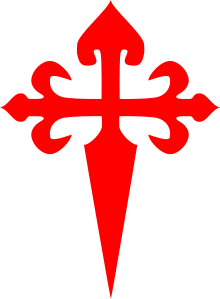Pedro Fernández de Castro (Grand Master of the Order of Santiago)
 Likeness of Pedro Fernández de Castro from a tapestry | |
| Order of Santiago Grand Master of the Order of Santiago | |
|
In office 1170–1184 | |
| Monarch |
Ferdinand II of León Alfonso VIII of Castile |
| Preceded by |
Ferdinand II of León Alfonso VIII of Castile |
| Succeeded by | Fernando Díaz |
Pedro Fernández de Castro, also known as Pedro Fernández de Fuentecalada (b. c. 1115-1184), was the first Grand Master or the Order of Santiago and the founder of the Monastery of Santa Cruz de Valcárcel. He was a Spanish nobleman and a member of the House of Castro.
Family origins
He was the son of Fernando García de Hita, a close kinsman of Queen Urraca of León and Castile and founder of the powerful Castro family, by his wife Estefanía Ermengol, daughter of Ermengol V, Count of Urgell.[1]
Biography

Pedro fought in the army of Alfonso VII of León and Castile in the conquest of Aurelia and Alharilla in the present day area of Santa Cruz de la Zarza. Later in 1146, he participated in further military campaigns, assisting in the occupation of Baeza and the landings in Almería. These actions were an important part of the overall military campaign because they devastated the Moorish navy and largely removed them from the war at large.
Later, while crusading in the Holy Land, he decided to create a new military order dedicated to protecting the sepulcher of James the Apostle and to protecting the Way of St. James.
On August 4, 1165, Pedro, together with his wife, his sister Urraca, and his children, donated a house to abbot Miguel in Santa Cruz de Valcárcel for the purpose of founding a monastery dedicated to the principles of the order. The donation was confirmed by his wive's brothers, Nuño and Álvaro Pérez de Lara, in addition to Gómez González de Manzanedo, the husband of Pedro's sister-in-law, Milia Pérez de Lara, as well as his brothers and other members of the Castro family. Later in that year, at the age of 50, Pedro Fernández officially founded the Order of Santiago in the city of Cáceres. The spirit of the order was born in the times of the Almohad invasion and is influenced by the Knights Templar, to which Pedro had become acquainted with in the Holy Land. His wife and daughter would later become nuns at the Monastery of Santa Cruz de Valcárcel.
Francisco de Rades y Andrada, in his chronicles of military orders, records Pedro's death in 1184, being buried in the main chapel of the Convent of San Marcos, León.
Marriage and descendants
Pedro Fernández married María Pérez de Lara, daughter of count Pedro González de Lara, with whom he had the following children:[2][3]
- Fernando Pérez de Castro: known as "Potestad". Married Teresa Bermúdez, with children.[4]
- Gómez Pérez de Castro, tenente of the territory of Santullán.
- Elo Pérez de Castro, first abbess at the Monasterio de Santa Cruz de Valcárcel.[5]
- María Pérez de Castro, also known as María de Aragón.
- Milia Pérez de Castro
Grand Master of the Order of Santiago 1170–1184 |
Succeeded by Fernando Díaz |
References
- ↑ As the queen's cousin, Fernando García has traditionally been placed as illegitimate son of King García II of Galicia, and this continues to be followed by some modern scholars (e.g. Torres Sevilla). Two genealogists (Canal and Salazar y Acha) have recently suggested an alternative, that Fernando was son of count García Ordóñez by Urraca Garcés the daughter of the Navarese King García Sánchez III of Navarre.
- ↑ His marriage and descendants are amply documented, especially in the documents kept at the Monasterio de Santa Cruz de Valcárcel, the Monastery of Santa María la Real in Aguilar de Campoo, and the Monasterio de San Román de Entrepeñas
- ↑ In 1206, María Pérez and her children, Fernando Pérez «la Podestá», Gómez Pérez, Eylo, María de Aragón, and Milia, on one part, and the prior of the Monastery of San Román de Entrepeñas, on the other, exchange a mill in Castellos for another property.
- ↑ (Torres 1999, p. 82)
- ↑ On 17 February 1219, in the documentation from the Monasterio de Santa Cruz de Valcarcel, King Fernando III grants his protection to the monastery and confirms the possession of the property donated to Elo, its abbess. ...quod vos donna Elo nunc de novo construiis sub regula Sanctii Benedicti, vobisque eiusdem monasterii instante abbatisse.
Biography
- Canal Sánchez-Pagín, José María (1984). Consejo Superior de Investigaciones Científicas, CSIC: Institución Milá y Fontanals. Departamento de Estudios Medievales, ed. "Don Pedro Fernández, primer maestre de la Orden Militar de Santiago: Su familia, su vida". Anuario de Estudios Medievales. 14. Madrid. pp. 33–72. ISSN 0066-5061.
- Salazar y Acha, Jaime de (1991). "El linaje castellano de Castro en el siglo XII: Consideraciones e hipótesis sobre su origen". Anales de la Real Academia Matritense de Heráldica (1). pp. 33–68. ISSN 1133-1240.
- Torres Sevilla-Quiñones de León, Margarita (1999). Linajes nobiliarios en León y Castilla siglos IX-XIII. Consejería de Educación y Cultura de Castilla y León. ISBN 84-7846-781-5.
- Ubieto Arteta, Antonio (1976). Cartulario de San Millán de la Cogolla (759-1076). Anubar Ediciones. ISBN 84-7013-082-X.